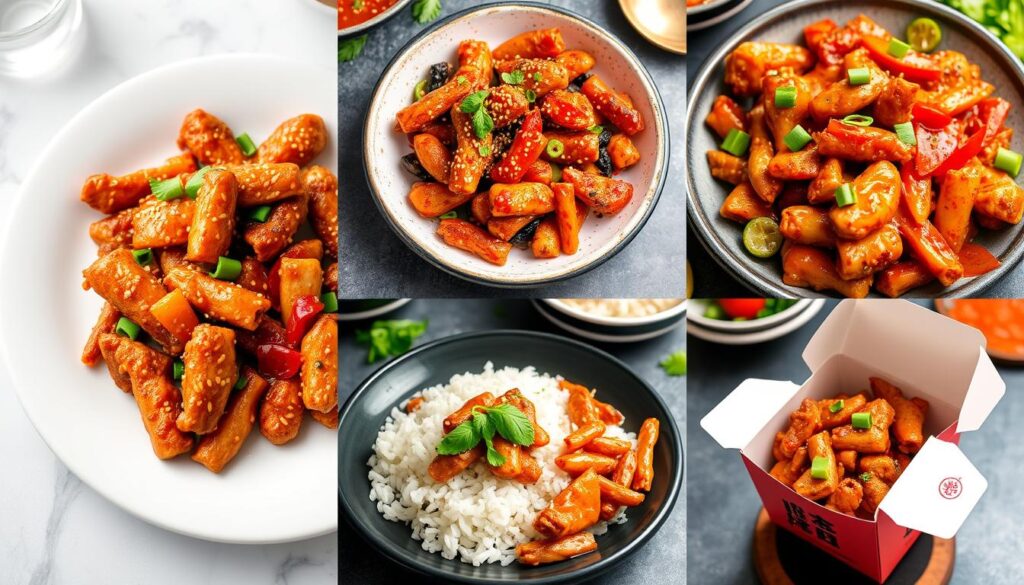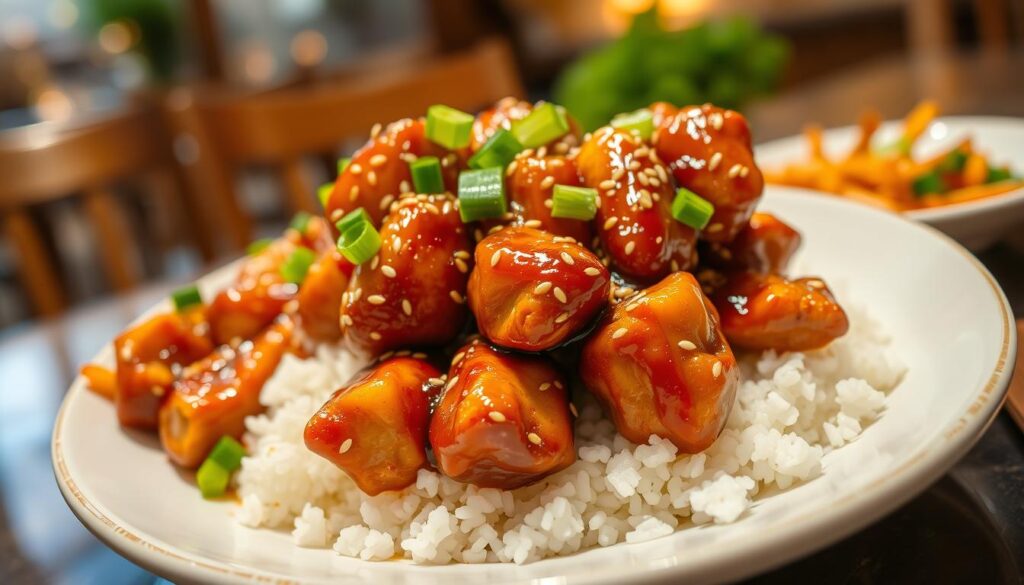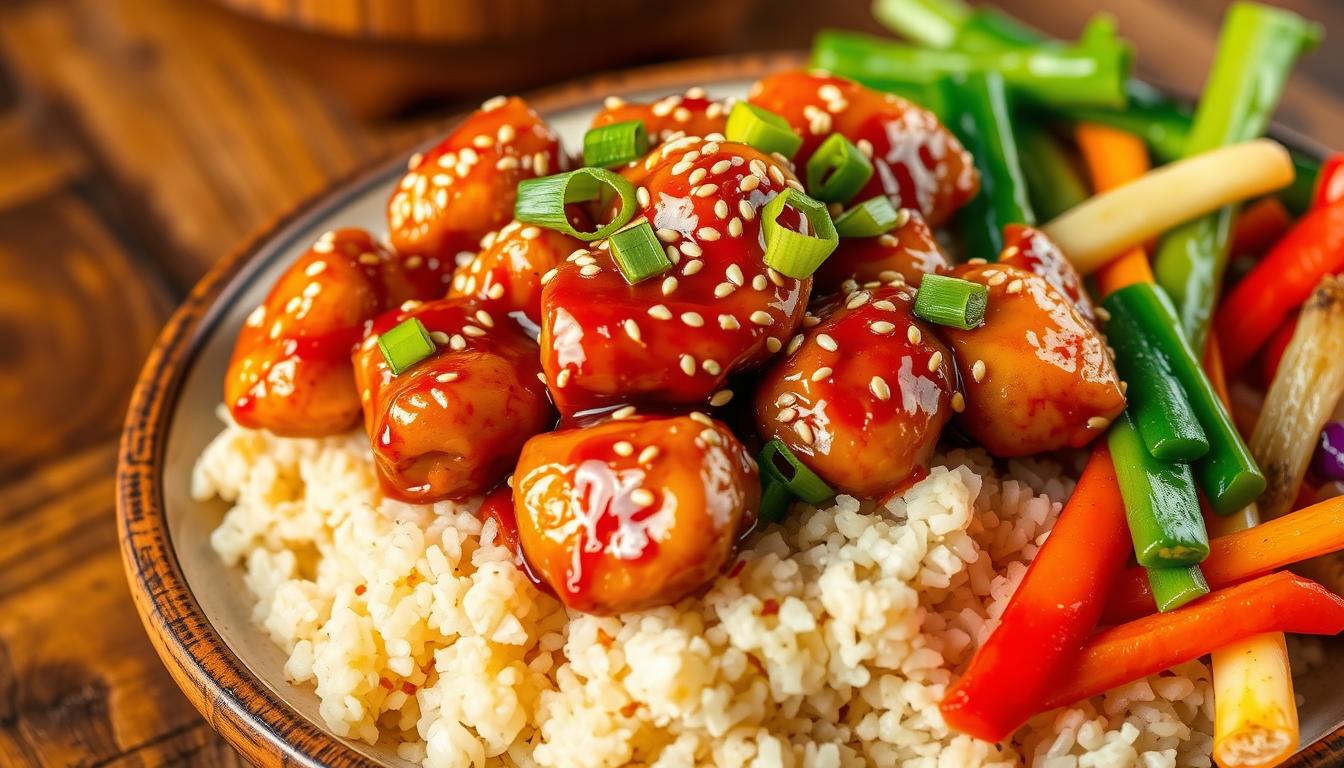The smell of sesame chicken in the kitchen brings back memories of family dinners. It reminds me of weekends spent enjoying our favorite takeout. When I’m busy, I often crave that comforting flavor found in Chinese food.
So, I decided to make sesame chicken at home. It’s not just a meal; it’s a cozy moment with loved ones. Each bite is a reminder of those special times. With simple ingredients and a bit of excitement, I can make it just like the restaurant.
Let’s explore this recipe that turns weeknight dinners into family feasts!
- Introduction to Sesame Chicken
- Why You’ll Love This Sesame Chicken Recipe
- Ingredients for Savory Sesame Chicken
- Step-by-Step Instructions for Cooking
- Tips for the Perfect chicken
- Serving Suggestions for Sesame Chicken
- Healthier Alternatives for Sesame Chicken
- History and Origins of Sesame Chicken
- Variations of Sesame Chicken in Asian Cuisine
- Storing and Reheating Leftovers
- Tips for Making Sesame Chicken Ahead of Time
- Why Sesame Chicken is a Family Favorite
- Conclusion
- Source Links

Introduction to Sesame Chicken
Sesame chicken is a favorite in Chinese food. It’s crispy fried chicken in a sweet and savory sauce. Introduced in Denver by Imperial Chinese Cuisine in 1985, it quickly became popular.
Imperial’s dishes, like spicy Szechwan and steamed bass, raised the bar. Their focus on quality made sesame chicken a hit with everyone. It’s loved by kids and adults.
Sesame chicken is known for its great taste and texture. It’s perfect for adding your own twist. Try my recipe to make this dish at home. Discover the joy of making sesame chicken in your kitchen.
Why You’ll Love This Sesame Chicken Recipe
This easy homemade recipe for restaurant-style sesame chicken is a hit. It’s quick to make, ready in just 22 minutes. This is great for busy nights when I want a homemade meal that tastes like takeout.
Quick and Easy Preparation Time
This recipe is simple and fast. Dinner is ready in under half an hour. Each serving has 2 cups of chicken, perfect for two, with only 417 calories.
I love how I can make it my own. It’s easy to adjust to my taste and diet needs. Plus, it’s easy to cook.
A Delicious Homemade Alternative to Takeout
This sesame chicken is a tasty swap for takeout. The flavors from sesame oil, scallions, ginger, and garlic are amazing. It’s a dish that beats store-bought meals any day.
By making it at home, I use quality ingredients. Boneless chicken and sesame seeds make it a hit with my family. We enjoy it together, right at home.
Ingredients for Savory Sesame Chicken
Making the perfect sesame chicken needs the right mix of flavors. Knowing the sesame chicken ingredients is key to making this tasty dish. Here, I list the main ingredients for a recipe that’s both tasty and fulfilling.
Key Ingredients You Need
- Chicken breast
- Cornstarch
- Honey
- Soy sauce
- Rice vinegar
- Sesame oil

These main ingredients are the base of my chicken recipe. Each one adds to the dish’s savory taste, making it unforgettable. The chicken breast is a lean protein, while honey and soy sauce add sweetness and depth.
Optional Ingredients to Customize Your Dish
Customizing your dish is part of the fun of cooking. This recipe lets you add your own twist. Try adding:
- Diced bell peppers
- Broccoli florets
- Snow peas
- Carrots, thinly sliced
These optional ingredients boost the dish’s health benefits and let you make it your own. You can also try using tofu or shrimp for a new take on sesame chicken.
Step-by-Step Instructions for Cooking
Making this dish at home is fun. Follow these easy steps to make a delicious dish. I’ll show you how to prepare the chicken and make the sauce.
Preparing the Chicken
Start with 1 pound of skinless boneless chicken thighs. Cut them into small pieces. Coat the chicken pieces with ¼ cup of cornstarch for a crispy exterior.
Make sure to coat the chicken well. This step is key for a great texture.
Making the Sauce
Now, let’s make the sauce. Mix ½ cup of honey, 2.5 tablespoons of soy sauce, and 2 tablespoons of sesame oil in a bowl. Add 3 minced garlic cloves, 2 teaspoons of Shaoxing Cooking Wine, and 2 teaspoons of rice vinegar. Mix until smooth and set aside.
Cooking the Dish
Heat ⅓ cup of vegetable oil in a deep pan over medium-high heat. Fry the chicken in batches until golden and crispy. Then, toss the chicken in the sauce until fully coated.
| Ingredient | Quantity |
|---|---|
| Skinless boneless chicken thighs | 1 lb |
| Cornstarch | ¼ cup |
| Vegetable oil | ⅓ cup |
| Honey | ½ cup |
| Soy sauce | 2.5 tablespoons |
| Sesame oil | 2 tablespoons |
| Sugar | ½ tablespoon |
| Garlic cloves | 3, minced |
| Shaoxing Cooking Wine | 2 teaspoons |
| Rice vinegar | 2 teaspoons |
| Water | ¾ cup |
Follow these steps for a tasty homemade chicken. Enjoy your meal and try different frying techniques for extra crunch!
Tips for the Perfect chicken
Making sesame chicken that wows is all about the details. The right frying methods and oils can make your dish as good as any restaurant’s. It’s all about getting that crispy, flavorful bite.
Frying Techniques for Crispy Chicken
Keeping an eye on the oil temperature is key. A thermometer helps you keep it between 350°F to 375°F. This ensures the chicken cooks evenly and gets that golden crust.
Frying in batches is another trick. Too much chicken at once can make it soggy. Small batches mean better texture and taste. These tips help you get that perfect crunch.
Choosing the Right Oil
Choosing the right oil is also important. Vegetable oil is great for frying because of its high smoke point and neutral taste. Canola and peanut oils are good alternatives for crispy results.
The right oil can make your sesame chicken taste better and stay healthy. For more tips and a detailed recipe, check out this resource.
Serving Suggestions for Sesame Chicken
Serving sesame chicken with the right sides makes it even better. I often pair it with fluffy rice and colorful veggies. These add to the meal’s flavor and make it more satisfying.
Pairing with Rice and Vegetables
Choosing the right rice is key for enjoying sesame chicken. White rice or quinoa work great, soaking up the sauce. Serving it with steamed broccoli or stir-fried veggies adds a healthy crunch and looks great.
Creative Side Dish Options
Trying new side dishes can make the meal exciting. Here are some of my favorites:
- Garlic sautéed green beans
- Pineapple fried rice
- Asian slaw for a refreshing contrast
- Sesame cucumber salad
These side dishes bring variety and make the sesame chicken even more enjoyable. Each part of the meal is a delight for the taste buds and the eyes.
Healthier Alternatives for Sesame Chicken
Looking for lighter versions of sesame chicken is a great way to eat healthy without losing flavor. I make this dish healthier by skipping the fryer and using sautéed chicken instead. This method cuts down on oil and makes for a tasty meal. Here are some tips for making a healthier sesame chicken that I love.
Lightened-up Versions Without Frying
I choose boneless, skinless chicken breasts or tenders for a healthier sesame chicken. These options are high in protein and low in fat and calories. Sautéing or stir-frying uses little oil, making the dish much leaner. Using coconut aminos instead of soy sauce keeps it soy-free, gluten-free, and sugar-free, perfect for paleo diets.
Using Alternative Proteins
For plant-based fans, I suggest tofu or tempeh. These add variety and make the dish vegetarian. The recipe can be easily changed to use these proteins, so everyone can enjoy it. Adding fresh garlic, ginger, and toasted sesame oil boosts the flavor and nutrition. Adding veggies like bell peppers or green veggies adds vitamins and balances the dish.
History and Origins of Sesame Chicken
The story of sesame chicken is both fascinating and delicious. It comes from the southern Chinese province of Guangdong. Many believe it was born in the 1980s at a Hong Kong restaurant. Today, it’s a hit in Chinese restaurants across the U.S. and Canada.
The recipe for sesame chicken blends traditional Chinese methods with Western twists. Unlike spicy General Tso’s chicken, it’s mild and sweet. The sauce, made from corn starch, vinegar, chicken broth, and sugar, is topped with sesame seeds for extra flavor and look.
There are many sesame chicken variations. Some use shrimp instead of chicken, while others offer a vegetarian version with tofu. These changes show how the dish can please many different tastes.
Sesame chicken became popular in America thanks to cultural exchanges and Chinese immigrants. It’s a great example of how food traditions can grow and change in new places. It connects people from different backgrounds through their love of food.
For a quick homemade sesame chicken, try a simple recipe. You can find one here. Its lasting appeal comes from pleasing many tastes and honoring its origins. It’s a true symbol of cultural fusion through food.
Variations of Sesame Chicken in Asian Cuisine
Asian cuisine offers a wide range of sesame chicken dishes. Each region adds its own twist, making the dishes unique. In China, sesame chicken is known for its glossy sauce, made from soy sauce and sesame oil.
In Japan, they add a crunchy touch with panko breadcrumbs. This shows how different ingredients and techniques can change a dish.
Thai cuisine brings a fresh twist to sesame chicken. It combines the chicken with herbs and coconut milk. This creates a sweet and spicy mix that’s both delightful and refreshing.

Other Asian dishes also share similarities with sesame chicken. Korean fried chicken, for example, has a sweet and spicy glaze. This shows how flavors and cooking styles can travel and evolve.
The many variations of sesame chicken celebrate the diversity of Asian cuisine. They tell us about the different tastes and traditions found across the continent. This makes sesame chicken more than just a dish; it’s a journey through flavors and cultures.
Storing and Reheating Leftovers
Keeping leftover sesame chicken fresh is key to its taste and texture. Use airtight containers in the fridge for up to three days. Freezing it in airtight containers or bags can extend its life to two months.
Reheating sesame chicken right can make a big difference. Try oven, stovetop, or microwave methods. Each has its own benefits. Here are some tips for reheating:
- Oven: Preheat to 350°F (175°C). Place the chicken on a baking sheet, covered with foil. Reheat for 15-20 minutes.
- Stovetop: Heat a skillet over medium. Add water or broth. Stir-fry until heated through, to keep it moist.
- Microwave: Use a microwave-safe bowl, covered with a damp paper towel. Heat in short bursts, stirring between, to avoid hot spots.
If the chicken seems dry, a little extra sauce or broth can help. These tips make reheating easy and keep flavors rich. They also make meal prep simpler for later.
| Method | Temperature | Time | Tips |
|---|---|---|---|
| Oven | 350°F (175°C) | 15-20 minutes | Cover with foil |
| Stovetop | Medium heat | 5-10 minutes | Add water or broth |
| Microwave | N/A | 2-3 minutes | Cover with damp paper towel |
For more reheating tips, check out this guide. Following these steps ensures you enjoy your sesame chicken, even on the second or third day!
Tips for Making Sesame Chicken Ahead of Time
When I think about making this dish ahead, several strategies come to mind. These strategies can simplify meal prep. Preparing various components in advance saves time and ensures a delicious dish is ready on busy days.
I often recommend marinating boneless, skinless chicken thighs overnight. This cut of chicken yields a juicier and more flavorful result. Mixing water in the marinade helps the chicken retain moisture even after frying, making it more tender.
To create the sauce, I gather ingredients like ketchup, sugar, vinegar, soy sauce, and dark soy sauce. Preparing the sauce ahead can streamline the cooking process later on. I also use cornstarch to thicken the sauce, which makes it glossy.
Here is a helpful breakdown of my meal prep options:
| Prep Option | Details |
|---|---|
| Marinate Chicken | Marinate overnight or for a few hours for rich flavor. |
| Prepare Sauce | Make the sauce in advance and store it in the refrigerator. |
| Cook Chicken | Fry chicken pieces in oil heated to around 375°F to ensure crispness. |
| Storing Leftovers | Keep refrigerated for 3-4 days, or freeze raw chicken with sauce for up to 6 months. |
Keeping the oil temperature consistent during frying is key. This ensures the chicken cooks evenly and crisps up nicely. If I have leftover sesame chicken, I reheat it in the oven at 325°F for about 10-12 minutes. I cover it with foil for the first part and remove it near the end to restore some crunch.
These easy cooking tips can make all the difference. Embracing the concept of making sesame chicken ahead not only transforms meal times but also brings ease and convenience to my busy schedule. For additional inspiration on quick dinners, I often refer to one-pot recipes that complement this delicious meal.
Why Sesame Chicken is a Family Favorite
Sesame chicken is a hit in many homes for its sweet and savory mix. It’s loved by both kids and adults, making it a favorite at family meals. Every time I make it, everyone wants more, showing its huge appeal.
Appealing to Kids and Adults Alike
The flavors in ths dish are perfect for families. Kids love its sweet taste, while adults enjoy the savory side. During lockdown, I made it so many times, and my family loved it every time.
It’s great with Jasmine Rice or Broccoli Rice, making it a meal everyone loves.
Here’s a comparison of the nutritional aspects of sesame chicken per serving:
| Nutrient | Content Per Serving |
|---|---|
| Total Calories | 513 kcal |
| Carbohydrates | 54 g |
| Protein | 44.5 g |
| Fat | 16 g |
| Saturated Fat | 2.5 g |
| Cholesterol | 124 mg |
| Sodium | 1115.5 mg |
| Fiber | 1.5 g |
| Sugar | 1 g |
This dish is not just tasty but also introduces kids to Asian recipes. It pairs well with other dishes like Thai Basil Chicken and Teriyaki Chicken. This makes mealtime fun and helps create lasting memories.

Conclusion
Making homemade sesame chicken is a fun way to enjoy a tasty meal. It’s quick, with only 25 minutes of cooking time. This makes it perfect for those looking for fast, delicious meals.
This recipe is not only easy to make but also healthier than takeout. It’s shallow-fried, which means less fat. This makes it a great choice for a quick, healthy meal.
You can also make it your own by adding different ingredients. Using arrowroot flour instead of cornstarch adds more fiber and nutrients. Choosing coconut aminos instead of soy sauce reduces sodium but keeps the flavor.
I suggest trying this recipe and making it your own. It’s a great addition to any dinner menu. Its quick preparation and healthy ingredients make it a favorite for many families.
Source Links
- Sesame Chicken – https://www.dinneratthezoo.com/lighter-honey-sesame-chicken/
- How To Make Easy Sesame Chicken That’s Fresher and Faster than Takeout – https://www.thekitchn.com/sesame-chicken-22925604

